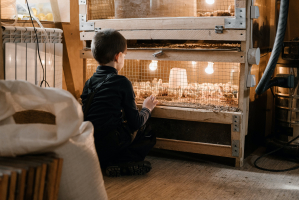Top 15 Best Personal Experience Narrative Essay Outline
Narrative essays offer writers the opportunity to express personal experiences, often in a compelling and thought provoking way. Crafting an effective personal ... read more...experience narrative essay requires a well structured outline to guide the storytelling process. In this article, Toplist provides the best personal experience narrative essay outlines to help writers create engaging and impactful narratives.
-
I. Brainstorming
Reflect on personal experiences:
a. Achieving a personal goal
b. Overcoming a significant challenge
c. A moment of personal growth and self-discoveryIdentify a central theme or message:
Perseverance and self-belief lead to personal triumph.
II. Selecting a Topic
Choose a relevant topic:Achieving a long time academic goal despite challenges.
Consider the topic's significance in your life:Reflect on the perseverance and determination required to overcome obstacles and reach the goal.
III. Introduction
Hook: Begin with a captivating anecdote about facing a challenging academic situation.
Scene Setting: Describe the setting, emotions, and the weight of the challenge.
Thesis Statement: "The moment I achieved [specific academic goal] stands as a testament to the power of perseverance, self belief, and the triumph of personal growth."IV. Body Paragraphs
Background/Offer necessary context: Detail the academic goal, its importance, and the obstacles faced.
Introduce the central conflict: Highlight the challenges faced in pursuing the goal, such as academic difficulties, time constraints or self-doubt.
Take readers to the climax: Describe the pivotal moment when the goal was achieved, creating suspense and anticipation.
Provide the resolution: Discuss the steps taken to overcome challenges and successfully achieve the academic goal.
Use vivid descriptions, character development, and dialogue:- Include sensory details, emotions, and personal reflections.
- Develop the character (you) by showcasing growth and resilience.
- Incorporate meaningful dialogue or internal monologue.
V. Conclusion
Restate the thesis: Reinforce the central theme of perseverance, self-belief, and personal triumph.
Summarize key points: Recap the significant challenges faced, the personal growth experienced, and the ultimate achievement of the academic goal.
End with a closing thought: Leave the reader with a reflective statement on the broader implications of the experience and its lasting impact on personal development.
Photo by Simon Berger via pexels 
Photo by Rodolfo Quirós via pexels -
I. Brainstorming
Reflect on personal experiences:
a. Initial thoughts and perceptions of opera
b. Feelings of excitement or apprehension
c. Influence of cultural background on expectationsIdentify a central theme or message: The transformative power of experiencing new cultural forms.
II. Selecting a Topic
Choose a relevant topic:Attending my first opera performance at [specific opera house].
Consider the topic's significance in your life: Reflect on the impact of cultural exposure and the expansion of personal horizons.III. Introduction
Hook: Begin with a vivid description of the exterior or grandeur of the opera house.
Scene Setting: Set the stage by describing the atmosphere, the anticipation in the air, and personal emotions.
Thesis Statement: "My first visit to [specific opera house] marked a pivotal moment in my cultural journey, challenging preconceptions and opening my eyes to the transformative power of the opera experience."IV. Body Paragraphs
Background/Offer necessary context: Introduce the decision to attend the opera and the background knowledge (or lack thereof) about opera.
Introduce the central conflict: Discuss any reservations or concerns about attending an opera, addressing stereotypes or misconceptions.
Take readers to the climax: Describe the moment of entering the opera house, the first glimpse of the stage, and the initial notes of the performance.Provide the resolution: Share the emotional and intellectual impact of the opera experience, detailing how perceptions changed or were enriched.
Use vivid descriptions, character development, and dialogue:- Depict the visual and auditory elements of the opera.
- Develop your character by expressing internal thoughts, emotions, and reactions.
- Include any notable dialogue or interactions with others during the experience.
V. Conclusion
Restate the thesis: Reinforce the central theme of cultural transformation through the opera experience.
Summarize key points: Summarize the journey from initial expectations to the transformative impact of the opera experience.
End with a closing thought: Conclude with a reflection on the broader significance of cultural exploration and the importance of embracing new and unfamiliar experiences.
Photo by Mudassir Ali via pexels 
Photo by Rijan Hamidovic via pexels -
I. Brainstorming
Reflect on personal experiences:
a. Recall bizarre or unexpected incidents witnessed
b. Consider the surroundings and people involved
c. Reflect on the emotions and reactions during the incidentIdentify a central theme or message: The unpredictability of life and the importance of being prepared for the unexpected.
II. Selecting a Topic
Choose a relevant topic:The strangest accident I witnessed: [specific incident].
Consider the topic's significance in your life:Reflect on how the incident left a lasting impression or changed your perspective.
III. Introduction
Hook:Begin with a gripping description of the ordinary setting leading up to the incident.
Scene Setting:Describe the atmosphere, the people around, and the events leading up to the accident.
Thesis Statement:"The weirdest accident I ever witnessed not only left me in awe of life's unpredictability but also taught me the importance of staying vigilant in even the most mundane situations."
IV. Body Paragraphs
Background/Offer necessary context:Introduce the setting, your presence and the seemingly ordinary circumstances leading up to the accident.
Introduce the central conflict:Describe the accident itself, emphasizing its bizarre or unexpected nature.
Take readers to the climax:Detail the immediate aftermath of the accident and the reactions of those involved.
Provide the resolution:Discuss any consequences, resolutions, or lessons learned from the incident.
Use vivid descriptions, character development, and dialogue:Paint a vivid picture of the accident scene and its impact on people.
Develop the characters involved, including their reactions and interactions.
Incorporate any memorable dialogue or internal reflections.V. Conclusion
Restate the thesis:Emphasize the central theme of life's unpredictability and the need for vigilance.
Summarize key points:Summarize the details of the bizarre accident and its aftermath.
End with a closing thought:Conclude with a reflection on the lasting impact of witnessing such an unusual incident, emphasizing the need to stay alert and adaptable in the face of life's surprises.

Photo by Pixabay via pexels 
Photo by Dominika Kwiatkowska via pexels -
I. Brainstorming
Reflect on personal experiences:
a. Initial thoughts or perceptions of Asian cuisine
b. Influence of cultural background on food preferences
c. Consider any hesitations or excitement about trying new foodsIdentify a central theme or message:
The transformative power of exploring and embracing diverse culinary experiences.
II. Selecting a Topic
Choose a relevant topic:My first encounter with Asian cuisine and the journey of expanding my palate.
Consider the topic's significance in your life:Reflect on how this experience broadened your culinary horizons and introduced you to new flavors.
III. Introduction
Hook:Begin with a vivid description of the decision to try Asian cuisine and the setting where it happened.
Scene Setting:Set the stage by describing the atmosphere, the restaurant, or the cultural context.
Thesis Statement:"My first foray into Asian cuisine was not just a culinary adventure but a transformative journey that opened my eyes to the richness of diverse flavors, textures, and cultural traditions."
IV. Body Paragraphs
Background/Offer necessary context:Introduce your initial exposure to the idea of trying Asian cuisine and the reasons behind the decision.
Introduce the central conflict:Discuss any reservations, hesitations, or uncertainties you had before trying Asian dishes.
Take readers to the climax:Describe the moment of trying your first Asian dish, including the sensory experience and initial reactions.
Provide the resolution:Share the evolution of your taste preferences, any surprises, and whether the experience influenced your future culinary choices.
Use vivid descriptions, character development, and dialogue:Depict the visual and olfactory aspects of the food.
Develop your character by expressing internal thoughts, emotions, and reactions.
Include any memorable dialogue or interactions with others during the culinary adventure.V. Conclusion
Restate the thesis:Reinforce the central theme of the transformative power of exploring diverse culinary experiences.
Summarize key points:Summarize the journey from initial reservations to embracing and enjoying Asian cuisine.
End with a closing thought:Conclude with a reflection on the lasting impact of this culinary adventure, whether it's an appreciation for diverse flavors or a broader openness to trying new things.

Photo by ELEVATE via pexels 
Photo by Chan Walrus via pexels -
I. Brainstorming
Reflect on personal experiences:
a. Recollect memorable birthday celebrations
b. Consider the emotions associated with receiving gifts
c. Identify a particularly special birthday presentIdentify a central theme or message:
The profound impact of a meaningful and thoughtful gift on one's life.
II. Selecting a Topic
Choose a relevant topic:My most memorable birthday present: [specific gift].
Consider the topic's significance in your life:Reflect on how this gift made the birthday exceptionally special and the lasting impact it had.
III. Introduction
Hook:Begin with a brief description of the anticipation and excitement leading up to the birthday celebration.
Scene Setting:Set the stage by describing the atmosphere, the people present, and the general mood.
Thesis Statement:"Among the many birthdays I've celebrated, one stands out vividly, marked by the most memorable and meaningful gift I have ever received, a gift that has left an indelible mark on my life."
IV. Body Paragraphs
Background/Offer necessary context:Introduce the context of the birthday celebration, including the people involved and the overall setting.
Introduce the central conflict:Describe the anticipation and the moment of receiving the most memorable birthday present.
Take readers to the climax:Detail the unveiling of the gift, the initial reactions, and the emotional impact.
Provide the resolution:Discuss the significance of the gift, how it enhanced the birthday celebration, and its lasting impact on your life.
Use vivid descriptions, character development, and dialogue:Depict the visual and emotional aspects of the gift.
Develop your character by expressing internal thoughts, emotions, and reactions.
Include any memorable dialogue or interactions related to the gift.V. Conclusion
Restate the thesis:Reinforce the central theme of the profound impact of a meaningful gift on one's life.
Summarize key points:Summarize the details of the birthday celebration, emphasizing the importance of the memorable gift.
End with a closing thought:Conclude with a reflection on the lasting significance of the gift, its role in shaping memories, and the gratitude for the thoughtfulness behind it.

Photo by Craig Adderley via pexels 
Photo by George Dolgikh via pexels -
I. Brainstorming
Reflect on personal thoughts:
a. Imagine being a character in a book
b. Consider the genre, setting, and role of the character
c. Explore feelings, actions, and experiences as a literary characterIdentify a central theme or message:
The transformative power of self-reflection and imagination.
II. Selecting a Topic
Choose a relevant topic:My imaginary journey as a character in a book and the insights gained from this creative exercise.
Consider the topic's significance in your life:Reflect on the value of imaginative thinking and its impact on self-awareness.
III. Introduction
Hook:Begin with a description of the idea of being a character in a book and the intrigue it holds.
Scene Setting:Set the stage by framing the narrative as a creative exploration of the imaginary realm.
Thesis Statement:"Embarking on the imaginative journey of becoming a character in a book allowed me to delve into uncharted territories of my psyche, offering profound insights into my desires, fears, and the potential for personal growth."
IV. Body Paragraphs
Background/Offer necessary context:Introduce the concept of becoming a character in a book, the genre, and the overall setting.
Introduce the central conflict:Describe the initial thoughts, emotions, and uncertainties about becoming a literary character.
Take readers to the climax:Detail the imaginative experiences, challenges faced, and personal growth achieved in the fictional world.
Provide the resolution:Discuss the insights gained from the imaginary journey and the impact on your real-life perspectives.
Use vivid descriptions, character development, and dialogue:Depict the visual and emotional aspects of the imaginary world.
Develop the character (you) by expressing internal thoughts, emotions, and reactions.
Include any meaningful dialogue or interactions with other characters in the imaginary realm.V. Conclusion
Restate the thesis:Reinforce the central theme of the transformative power of self-reflection and imagination.
Summarize key points:Summarize the details of the imaginary journey, emphasizing personal growth and insights.
End with a closing thought:Conclude with a reflection on the importance of creative thinking, self-reflection, and the potential for personal growth through imaginative exercises.

Photo by Pixabay via pexels 
Photo by Pixabay via pexels -
I. Brainstorming
Reflect on personal experiences:
a. Recall poignant memories that evoke strong positive emotions
b. Identify a specific moment that stands out as particularly cherished
c. Reflect on the feelings and details associated with this memoryIdentify a central theme or message:
The enduring impact of a cherished memory on personal happiness and well-being.
II. Selecting a Topic
Choose a relevant topic:The memory I wish I lived through again: [specific moment].
Consider the topic's significance in your life:Reflect on the reasons why this memory holds a special place in your heart and the impact it had on your life.
III. Introduction
Hook:Begin with a brief description of the emotions and nostalgia associated with the memory.
Scene Setting:Set the stage by providing context for the memory, including the time, place, and people involved.
Thesis Statement:"Among the many memories that have shaped my life, there's one in particular that stands as a beacon of joy and warmth, a memory I yearn to relive for its profound impact on my happiness and well-being."
IV. Body Paragraphs
Background/Offer necessary context:Introduce the memory, its significance, and the reasons it stands out among others.
Introduce the central conflict:Explore the circumstances leading up to the cherished moment and the emotions felt.
Take readers to the climax:Describe the moment itself, emphasizing the sensory details, emotions, and significance.
Provide the resolution:Discuss the lasting impact of the memory on your life and how it continues to influence your perspective.
Use vivid descriptions, character development, and dialogue:Depict the visual, auditory, and emotional aspects of the memory.
Develop the character (you) by expressing internal thoughts, emotions, and reactions.
Include any meaningful dialogue or interactions that occurred during the cherished moment.V. Conclusion
Restate the thesis:Reinforce the central theme of the enduring impact of cherished memories on personal happiness.
Summarize key points:Summarize the details of the cherished memory and its significance.
End with a closing thought:Conclude with a reflection on the timeless nature of cherished memories, expressing the desire to relive such moments and the gratitude for the lasting joy they bring.

Photo by Rodolfo Clix via pexels 
Photo by Lisa Fotios via pexels -
I. Brainstorming
Reflect on personal thoughts:
a. Imagine being your favorite movie superhero
b. Consider the superhero's characteristics, powers, and moral code
c. Explore how embodying these traits might impact your lifeIdentify a central theme or message:
The potential for personal growth and positive impact through adopting the qualities of a favorite movie superhero.
II. Selecting a Topic
Choose a relevant topic:If I were my favorite movie superhero: [specific superhero].
Consider the topic's significance in your life:Reflect on how embodying the superhero's characteristics might lead to personal development and positive change.
III. Introduction
Hook:Begin with a dynamic description of the superhero and your connection to the character.
Scene Setting:Set the stage by describing the circumstances that lead to you adopting the superhero's persona.
Thesis Statement:"In a world where reality meets fantasy, stepping into the shoes of my favorite movie superhero, [specific superhero], has not only been an exhilarating journey but a transformative one, revealing the untapped potential within myself and the positive impact it can have on the world around me."
IV. Body Paragraphs
Background/Offer necessary context:Introduce the superhero, your connection to the character, and the decision to embody their persona.
Introduce the central conflict:Describe any challenges or doubts you faced in adopting the superhero's traits into your own life.
Take readers to the climax:Detail the experiences of embracing the superhero's characteristics, the impact on your actions, and the reactions of those around you.
Provide the resolution:Discuss the personal growth achieved and the positive changes brought about by embodying the superhero's persona.
Use vivid descriptions, character development, and dialogue:Depict the visual and emotional aspects of adopting the superhero persona.
Develop your character by expressing internal thoughts, emotions, and reactions.
Include any meaningful dialogue or interactions that highlight the impact of your superhero persona.V. Conclusion
Restate the thesis:Reinforce the central theme of personal growth and positive impact through adopting the traits of a favorite movie superhero.
Summarize key points:Summarize the details of your journey as the superhero and the transformative effects on your life.
End with a closing thought:Conclude with a reflection on the enduring lessons learned from the experience, expressing gratitude for the superhero's influence on personal development and the potential for positive change.

Photo by Ahmad Qime via pexels 
Photo by Ronê Ferreira via pexels -
I. Brainstorming
Reflect on personal experiences:
a. Recall a situation where you lost something that didn't belong to you
b. Consider the circumstances leading up to the loss
c. Reflect on the emotions, actions, and consequences associated with the incidentIdentify a central theme or message:
The lessons learned from unintended mistakes and their impact on personal responsibility.
II. Selecting a Topic
Choose a relevant topic:How I lost a thing that wasn't mine: [specific incident].
Consider the topic's significance in your life:Reflect on the consequences of the incident and the lessons it taught you about responsibility and accountability.
III. Introduction
Hook:Begin with a description of the setting, the object lost, and the initial emotions associated with the incident.
Scene Setting:Set the stage by providing context for the situation, such as the place and people involved.
Thesis Statement:"The day I unintentionally lost something that didn't belong to me became a pivotal moment in my life, teaching me valuable lessons about responsibility, accountability, and the consequences of unintended actions."
IV. Body Paragraphs
Background/Offer necessary context:Introduce the situation, the object lost, and the circumstances leading up to the incident.
Introduce the central conflict:Describe the moment of realization that you had lost something that wasn't yours and the immediate emotions that followed.
Take readers to the climax:Detail the actions taken in an attempt to rectify the situation, any struggles faced, and the consequences of the loss.
Provide the resolution:Reflect on the lessons learned, personal growth achieved, and any resolution or consequences that followed the incident.
Use vivid descriptions, character development, and dialogue:Depict the visual and emotional aspects of the incident.
Develop your character by expressing internal thoughts, emotions, and reactions.
Include any meaningful dialogue or interactions related to the loss.V. Conclusion
Restate the thesis:Reinforce the central theme of the incident teaching valuable lessons about responsibility and accountability.
Summarize key points:Summarize the details of the incident, the emotional impact, and the lessons learned.
End with a closing thought:Conclude with a reflection on the enduring impact of the incident, expressing gratitude for the lessons learned and the personal growth that resulted from the experience.

Photo by Pixabay via pexels 
Photo by Nikita Khandelwal via pexels -
I. Brainstorming
Reflect on personal experiences:
a. Consider the excitement and anticipation of your first trip to the sea
b. Reflect on the emotions associated with the journey and arrival
c. Explore the sensory details and memorable moments during the tripIdentify a central theme or message:
The transformative power of new experiences and the awe-inspiring beauty of the sea.
II. Selecting a Topic
Choose a relevant topic:My first travel to the sea: [specific destination].
Consider the topic's significance in your life:Reflect on how this experience broadened your horizons, created lasting memories, and possibly changed your perspective on the world.
III. Introduction
Hook:Begin with a description of the excitement and anticipation leading up to your first trip to the sea.
Scene Setting:Set the stage by describing the journey, the mode of transportation, and the emotions accompanying the experience.
Thesis Statement:"The journey to the sea marked a significant milestone in my life, introducing me to the vast beauty of the ocean, and leaving an indelible mark on my memories as a transformative and awe-inspiring experience."
IV. Body Paragraphs
Background/Offer necessary context:Introduce the decision to travel to the sea, the reasons behind it, and the anticipation leading up to the journey.
Introduce the central conflict:Describe any challenges, uncertainties, or surprises encountered during the journey.
Take readers to the climax:Detail the first sight of the sea, the sensory experience, and the overwhelming emotions of arrival.
Provide the resolution:Share the memorable moments at the sea, the impact on your perspective, and any personal growth or insights gained.
Use vivid descriptions, character development, and dialogue:Depict the visual, auditory, and emotional aspects of the journey.
Develop your character by expressing internal thoughts, emotions, and reactions.
Include any meaningful dialogue or interactions that occurred during the trip.V. Conclusion
Restate the thesis:Reinforce the central theme of the transformative power of the first journey to the sea.
Summarize key points:Summarize the details of the journey, the arrival, and the impact on your perspective.
End with a closing thought:Conclude with a reflection on the enduring significance of this first sea travel, expressing gratitude for the memories created and the personal growth achieved through the experience.

Photo by Pixabay via pexels 
Photo by Asad Photo Maldives via pexels -
I. Brainstorming
Reflect on personal characteristics:
a. Identify distinctive personality traits
b. Consider unique talents, skills, or hobbies
c. Explore experiences that have shaped your identityIdentify a central theme or message:
Celebrating individuality and embracing personal uniqueness.
II. Selecting a Topic
Choose a relevant topic:What makes me unique: Exploring the facets of my identity that set me apart.
Consider the topic's significance in your life:Reflect on the importance of self-discovery and accepting one's uniqueness.
III. Introduction
Hook:Begin with a thought-provoking question or a brief reflection on the concept of individuality.
Scene Setting:Set the stage by introducing the idea of exploring what makes you unique and the significance of this self-discovery.
Thesis Statement:"Embracing my uniqueness has been a journey of self-discovery, as I explore the distinct traits, talents, and experiences that shape my identity and contribute to the tapestry of who I am."
IV. Body Paragraphs
Background/Offer necessary context:Introduce the idea of self-exploration and the motivation behind delving into what makes you unique.
Introduce the central conflict:Discuss any challenges or uncertainties you may have faced in recognizing and celebrating your uniqueness.
Take readers to the climax:Explore the specific traits, talents, or experiences that make you unique, providing vivid examples and anecdotes.
Provide the resolution:Discuss the impact of embracing your uniqueness on your self-esteem, relationships, or personal growth.
Use vivid descriptions, character development, and dialogue:Depict the visual, auditory, and emotional aspects of your unique traits and experiences.
Develop your character by expressing internal thoughts, emotions, and reflections.
Include any meaningful dialogue or interactions that highlight your uniqueness.V. Conclusion
Restate the thesis:Reinforce the central theme of celebrating individuality and self-discovery.
Summarize key points:Summarize the unique traits, talents, and experiences discussed in the essay.
End with a closing thought:Conclude with a reflection on the ongoing journey of self-discovery, expressing gratitude for what makes you unique and the value it adds to your life and the world around you.

Photo by Andrea Piacquadio via pexels 
Photo by Elevate Digital via pexels -
I. Brainstorming
Reflect on personal experiences:
a. Consider the excitement and anticipation of your first wilderness adventure
b. Reflect on the emotions associated with being in the wild
c. Explore the sensory details and memorable moments during the tripIdentify a central theme or message:
The transformative power of nature and the lessons learned from the wilderness.
II. Selecting a Topic
Choose a relevant topic:My first trip into the wild: [specific location or experience].
Consider the topic's significance in your life:Reflect on how this experience broadened your horizons, connected you with nature, and potentially changed your perspective on life.
III. Introduction
Hook:Begin with a description of the allure of the wilderness and the anticipation leading up to your first trip.
Scene Setting:Set the stage by describing the journey, the natural surroundings, and the emotions accompanying the experience.
Thesis Statement:"Embarking on my first trip into the wild opened my eyes to the raw beauty of nature, providing me with a profound connection to the wilderness and imparting valuable lessons that continue to shape my perspective on life."
IV. Body Paragraphs
Background/Offer necessary context:Introduce the decision to venture into the wild, the reasons behind it, and the anticipation leading up to the journey.
Introduce the central conflict:Describe any challenges, uncertainties, or surprises encountered during the trip into the wild.
Take readers to the climax:Detail the first experiences in the wilderness, the sensory details, and the overwhelming emotions of being immersed in nature.
Provide the resolution:Share the memorable moments, lessons learned, and the impact of the wild adventure on your perspective.
Use vivid descriptions, character development, and dialogue:Depict the visual, auditory, and emotional aspects of the journey into the wild.
Develop your character by expressing internal thoughts, emotions, and reflections.
Include any meaningful dialogue or interactions that occurred during the wilderness adventure.V. Conclusion
Restate the thesis:Reinforce the central theme of the transformative power of nature and the lessons learned in the wild.
Summarize key points:Summarize the details of the wild adventure, the emotional impact, and the lessons learned.
End with a closing thought:Conclude with a reflection on the enduring significance of this first trip into the wild, expressing gratitude for the connection with nature and the valuable lessons gained through the experience.

Photo by Peter Holmes via pexels 
Photo by Pixabay via pexels -
I. Brainstorming
Reflect on personal experiences:
a. Consider the emotions and expectations leading up to your first job interview
b. Reflect on the preparation process, including researching the company and rehearsing answers
c. Explore the actual interview experience and any notable momentsIdentify a central theme or message:
The lessons learned from the challenges and triumphs of a first job interview.
II. Selecting a Topic
Choose a relevant topic:My first job interview: [specific company or position].
Consider the topic's significance in your life:Reflect on how this experience shaped your approach to professional opportunities and your understanding of the interview process.
III. Introduction
Hook:Begin with a description of the nervous excitement and anticipation leading up to your first job interview.
Scene Setting:Set the stage by introducing the company, the position, and the circumstances that led to the interview.
Thesis Statement:"My first job interview marked a significant milestone in my professional journey, teaching me valuable lessons about preparation, confidence, and resilience that continue to influence my approach to career opportunities."
IV. Body Paragraphs
Background/Offer necessary context:Introduce the job opportunity, the reasons behind applying, and the initial excitement and nerves.
Introduce the central conflict:Describe the challenges and uncertainties you faced during the preparation process.
Take readers to the climax:Detail the actual interview experience, the questions asked, and your reactions in the moment.
Provide the resolution:Discuss the aftermath of the interview, whether you got the job or not, and the lessons learned from the experience.
Use vivid descriptions, character development, and dialogue:Depict the visual and emotional aspects of the interview process.
Develop your character by expressing internal thoughts, emotions, and reflections.
Include any meaningful dialogue or interactions with interviewers.V. Conclusion
Restate the thesis:Reinforce the central theme of the lessons learned from the challenges and triumphs of a first job interview.
Summarize key points:Summarize the details of the interview, the emotional impact, and the lessons learned.
End with a closing thought:Conclude with a reflection on the enduring significance of this first job interview, expressing gratitude for the experience and the growth it brought to your professional journey.

Photo by Christina Morillo via pexels 
Photo by Christina Morillo via pexels -
I. Brainstorming
Reflect on personal experiences:
a. Identify a significant loss that had a profound impact on your life
b. Consider the emotions and challenges associated with the loss
c. Reflect on how this loss shaped your perspective and personal growthIdentify a central theme or message:
The transformative power of coping with and learning from significant loss.
II. Selecting a Topic
Choose a relevant topic:My most significant loss: [specific event or relationship].
Consider the topic's significance in your life:Reflect on how this loss changed your outlook, resilience, and understanding of life.
III. Introduction
Hook:Begin with a poignant description of the event or relationship that led to your most significant loss.
Scene Setting:Set the stage by providing context for the loss, including the emotional atmosphere and personal connections.
Thesis Statement:"The loss of [specific event or relationship] stands as the most significant turning point in my life, shaping my resilience, altering my perspective on loss, and guiding my journey toward personal growth."
IV. Body Paragraphs
Background/Offer necessary context:Introduce the circumstances surrounding the loss, the relationship, or the significance of the event.
Introduce the central conflict:Describe the emotional turmoil, challenges, and uncertainties you faced during and after the loss.
Take readers to the climax:Detail the most intense and impactful moments of the loss, emphasizing the emotional weight and personal struggles.
Provide the resolution:Discuss the aftermath of the loss, how you coped, and the lessons learned through the grieving process.
Use vivid descriptions, character development, and dialogue:Depict the visual and emotional aspects of the loss.
Develop your character by expressing internal thoughts, emotions, and reflections.
Include any meaningful dialogue or interactions related to the significant loss.V. Conclusion
Restate the thesis:Reinforce the central theme of the transformative power of coping with and learning from significant loss.
Summarize key points:Summarize the details of the loss, the emotional impact, and the lessons learned.
End with a closing thought:Conclude with a reflection on the enduring significance of this most significant loss, expressing gratitude for the lessons learned and the personal growth that resulted from the experience.

Photo by Pavel Danilyuk via pexels 
Photo by Pavel Danilyuk via pexels -
I. Brainstorming
Reflect on personal experiences:
a. Identify a Christmas that stands out as particularly memorable
b. Consider the emotions, traditions, and events associated with that Christmas
c. Reflect on the significance of this Christmas in your lifeIdentify a central theme or message:
The enduring joy and significance of a particularly memorable Christmas.
II. Selecting a Topic
Choose a relevant topic:My most memorable Christmas: [specific year or event].
Consider the topic's significance in your life:Reflect on how this Christmas brought joy, strengthened relationships, or left a lasting impact.
III. Introduction
Hook:Begin with a festive and warm description of the holiday season, setting the tone for the memorable Christmas.
Scene Setting:Set the stage by introducing the setting, traditions, and the anticipation leading up to that Christmas.
Thesis Statement:"Among the many Christmases I've celebrated, one stands out as the most memorable, a day filled with joy, love, and unforgettable moments that continue to warm my heart even years later."
IV. Body Paragraphs
Background/Offer necessary context:Introduce the circumstances leading up to that Christmas, including the time, place, and people involved.
Introduce the central conflict:Describe any challenges, uncertainties, or unexpected events that added a unique flavor to the Christmas celebration.
Take readers to the climax:Detail the most joyous and memorable moments of that Christmas, emphasizing the emotional highlights and cherished experiences.
Provide the resolution:Discuss the aftermath of the memorable Christmas, its impact on your perspective, and any lasting traditions or memories.
Use vivid descriptions, character development, and dialogue:Depict the visual, auditory, and emotional aspects of the memorable Christmas.
Develop your character by expressing internal thoughts, emotions, and reflections.
Include any meaningful dialogue or interactions related to the special Christmas.V. Conclusion
Restate the thesis:Reinforce the central theme of the enduring joy and significance of a particularly memorable Christmas.
Summarize key points:Summarize the details of the memorable Christmas, emphasizing the emotional impact and lasting memories.
End with a closing thought:Conclude with a reflection on the enduring warmth and joy that this Christmas brought to your life, expressing gratitude for the meaningful moments and the lasting impact on your holiday traditions.

Photo by Kristina Paukshtite via pexels 
Photo by Jameel Hassan via pexels




































